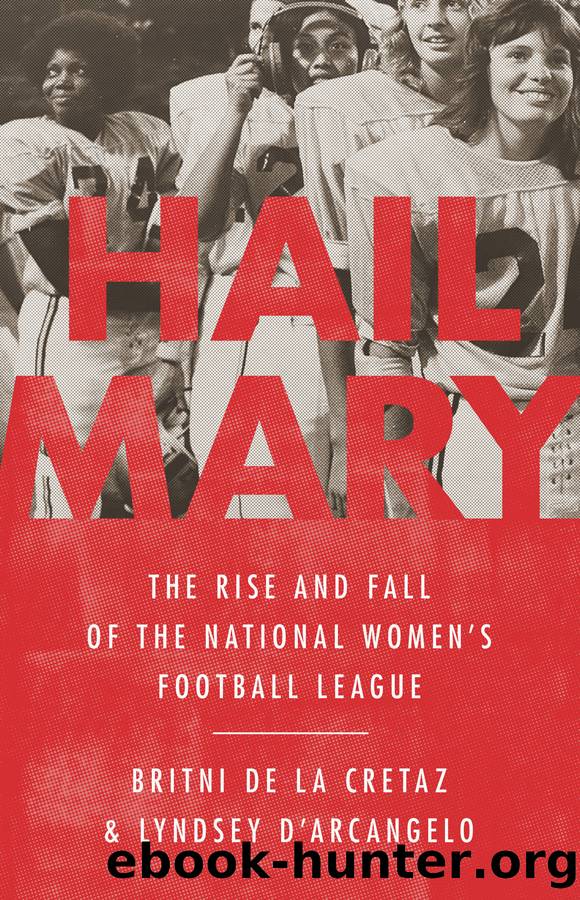Hail Mary: The Rise and Fall of the National Women's Football League by Britni de la Cretaz & Lyndsey D'Arcangelo

Author:Britni de la Cretaz & Lyndsey D'Arcangelo [Cretaz, Britni de la & D'Arcangelo, Lyndsey]
Language: eng
Format: epub
Tags: Social Science, Feminism & Feminist Theory, Sports & Recreation, Football, history
ISBN: 9781645036623
Google: K9pUzgEACAAJ
Publisher: PublicAffairs
Published: 2021-11-15T23:35:36.930441+00:00
CHAPTER 11
DOWN IN OKLAHOMA
As if fate intervened, the Oklahoma City Dolls arrived in 1976 just in time to inject some drama and excitement into the NWFL and provide serious competition for the Toledo Troopers. They had the size, skill, coaching, and talentâplayers like Mary BlueJacket, Cindee Herron, and Doris Stokesâto propel them to one of the top teams in the league right from the start.
One player who suited up for the Dolls was twenty-five-year-old Charlotte Shoate Gordon. The elementary school teacherâs maiden name would have been familiar to any Oklahoma college sports fan. Her brothers, Rod and Myron, played football for the University of Oklahoma. Rod would go on to spend six seasons in the NFL with the New England Patriots and was inducted into the College Football Hall of Fame in 2013. Gordon knew what it was like both on the field and on the sidelines. She played both ways for the Dolls as an end and a linebacker; sheâd also been a cheerleader at OU.
Gordon was born and raised in the small, then-unincorporated town of Fort Coffee, Oklahoma, outside Spiro near the Arkansas border. It is located within the Choctaw Nation tribal jurisdiction, and her great-grandparents, who were Choctaw freedmen, settled in the area after enslavement. It was an agrarian community, located just south of a bend in the Arkansas River, and Gordon lived on a farm with her nine siblingsâGordon was number eight of tenâand their parents, Levester and Lula Shoate. The family all pitched in on the farm, and when they were able to purchase a tractor, which made the job easier, Levester opened a grocery store for the small, close-knit community.
While in junior college, Gordon had received a scholarship to go to college in Iowa. While she was there, she got a call from some of the coaches at OU. They wanted Rod to play for them, and they wanted her help convincing him to go there. Their parents, too, didnât want Rod to miss out on the opportunity to play for Oklahoma. Rod said he would only attend if Gordon did, too, so she gave up her scholarship to come home. By the time the Dolls came around, she had graduated, gotten married, and was working as a teacher. Her friend Doris Stokes recruited her to come out for the team.
Gordon was adamant that she wasnât following in her brothersâ footstepsââIâm setting a precedent,â she told the Daily Oklahoman. âI donât like to be compared to them.⦠Itâs not a hereditary thing. I just try to do my best.â Gordon also disputed her coach Mike Reynoldsâs characterization about the disposition of his players as making it hard to adapt to the game of football. âMost of us out here have a natural ability,â she said. She stands by that assessment today: âI have a name. I donât go on [my brothersâ] coattails. They have gone on mine, but I do my own and they do their own.â
Download
This site does not store any files on its server. We only index and link to content provided by other sites. Please contact the content providers to delete copyright contents if any and email us, we'll remove relevant links or contents immediately.
| Anthropology | Archaeology |
| Philosophy | Politics & Government |
| Social Sciences | Sociology |
| Women's Studies |
Born to Run: by Christopher McDougall(6898)
The Leavers by Lisa Ko(6808)
iGen by Jean M. Twenge(5167)
Sapiens by Yuval Noah Harari(5126)
The Kite Runner by Khaled Hosseini(4960)
Spare by Prince Harry The Duke of Sussex(4800)
Bullshit Jobs by David Graeber(3847)
Machine Learning at Scale with H2O by Gregory Keys | David Whiting(3654)
Never by Ken Follett(3545)
Livewired by David Eagleman(3535)
Goodbye Paradise(3459)
Fairy Tale by Stephen King(2962)
A Dictionary of Sociology by Unknown(2862)
Harry Potter 4 - Harry Potter and The Goblet of Fire by J.K.Rowling(2815)
The Social Psychology of Inequality by Unknown(2771)
The Club by A.L. Brooks(2755)
People of the Earth: An Introduction to World Prehistory by Dr. Brian Fagan & Nadia Durrani(2620)
0041152001443424520 .pdf by Unknown(2608)
Will by Will Smith(2589)
